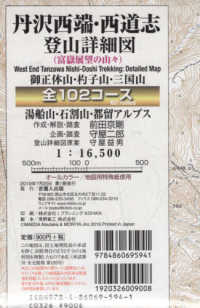- ホーム
- > 洋書
- > 英文書
- > Science / Mathematics
基本説明
Presents the main features of the Wasan tradition, which is a mathematical tradition which developed during the Edo period. It gives a description of the first mathematical textbooks published in the 17th century, then shifts to the work of the two leading mathematicians of this tradition, Seki Takakazu et Takebe Katahiro. The book provides substantial information on the historical and intellectual context, the role played by the Chinese mathematical treatises introduced at the late 16th century, and an analysis of Seki's and Takebe's contribution to the development of algebra and calculus in Japan.
Full Description
More than ?fteen years have passed since this book was published in French. Ideally this work, which originated from a doctoral thesis defended in 1990 at the University of Paris Diderot, should have been partially rewritten for the English edition, thereby incorporating the latest research results in its argumentation. But this was not the choice taken, since it would have delayed making this work, which brings together useful information for all those who are interested in wasan and eager to delve more deeply into its tradition, available to the English reader. Indeed, the special feature of this study is to present a high-level mathematical production while at the same time placing it in its historical context. This context here is Tokugawa Japan and, more speci?cally, the milieu of the scholars of samurai (warrior) origin. While explaining the indispensable social, economical and poli- cal background, we have not neglected mathematical analysis, since wasan reached its most beautiful results with the two mathematicians Seki Takakazu and Takebe Katahiro. Their works abound in lessons, not only for all those who are interested in the history of algebra and of analysis, but also in epistemological questions.
Contents
The Beginnings of Wasan.- The Jink?ki (1627) by Yoshida Mitsuyoshi.- The Jugairoku (1639) by Imamura Tomoaki.- The Sanso (1663) by Muramatsu Shigekiyo.- The Treatise of Ancient and Modern Mathematics (1671) by Sawaguchi Kazuyuki.- Seki Takakazu, His Time and His Mathematical Works.- Seki Takakazu (?-1708) and His Time.- The Works of Seki Takakazu on Techniques for Solving Problems.- Takebe Katahiro, Mathematician and Advisor of the Shogun.- The Career of Takebe Katahiro as Advisor of the Sh?gun.- Takebe's Works on Trigonometry.- Conclusion.








